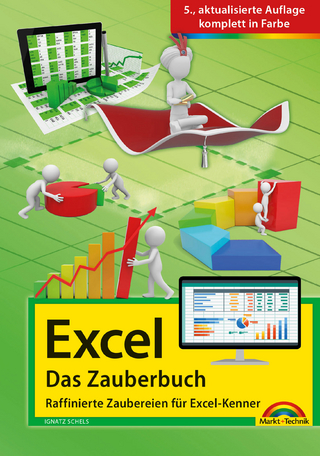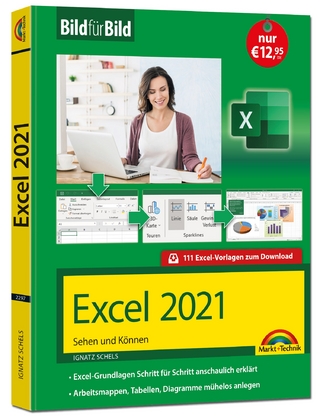
Engineering with Excel
Pearson (Verlag)
978-0-13-458966-4 (ISBN)
Gives Students A Foundation In Excel Functions For Various Engineering Purposes
Engineering With Excel, 5th Edition introduces students to all of the functions and ways to use Microsoft’s Excel 2016 on Windows 10, the most up-to-date version of the program. The text gives students an understanding of the many ways Excel can be used for engineering purposes. Chapters on graphing, matrix operations, linear regressions and statistics give students a foundation in computational math, while sections on using excel for finance and extending it to other computer programs helps students apply Excel to their broader lives. Finally, students will learn to write their own excel functions.
Ronald W. Larsen, Ph.D., P.E., is the Department Head of the Chemical and Biological Engineering Department at Montana State University.
1. Introduction to Excel
1.1 Introduction
1.2 What's New in Excel 2016?
1.3 A Little Windows®
1.4 Excel Basics
1.5 Organizing Your Worksheets
1.6 Printing the Worksheet
1.7 Saving and Opening Workbooks, Exiting Excel
2. Using Excel's Ribbon
2.1 Navigating the Ribbon
2.2 Using the Clipboard Group
2.3 Using the Font Group
2.4 Using the Alignment Group
2.5 Formatting Numbers
2.6 Using the Styles Group
2.7 Inserting, Deleting, and Formatting Rows and Columns
3. Graphing with Excel
3.1 Introduction
3.2 Getting Ready to Graph
3.3 Creating an Xy Scatter Graph
3.4 Editing an Existing Graph
3.5 Printing the Graph
3.6 Other Types of Graphs
3.7 Graphing Web Data
3.8 Importing Text Files
4. Excel Functions
4.1 Introduction to Excel Functions
4.2 Excel's Built-in Functions
4.3 Using the Convert Function to Convert Units
4.4 Simple Math Functions
4.5 Computing Sums
4.6 Trigonometric Functions
4.7 Advanced Math Functions
4.8 Error Function
4.9 Bessel Functions
4.10 Working with Complex Numbers
4.11 Working with Binary, Octal, and Hexadecimal Values
4.12 Miscellaneous Functions
5. Matrix Operations in Excel
5.1 Introduction
5.2 Matrices, Vectors, and Arrays
5.3 How Excel Handles Matrix Math
5.4 Basic Matrix Operations
5.5 Solving Systems of Linear Equations
6. Linear Regression in Excel
6.1 Introduction
6.2 Linear Regression Using Excel Functions
6.3 Linear Regression Using Excel's Trendlines
6.4 Other Two-Coefficient Linear Regression Models
6.5 Polynomial Regression
6.6 Linear Regression Using Excel's Regression Analysis Package
7. Excel's Statistics Functions
7.1 Overview
7.2 Populations and Samples
7.3 Standard Deviations and Variances
7.4 Errors, Deviations, and Distributions
7.5 Confidence Intervals
8. Excel's Financial Functions
8.1 Time, Money, and Cash Flows
8.2 Interest Rates and Compounding
8.3 Moving Amounts Through Time
8.4 Net Present Value
8.5 Internal Rate of Return
8.6 Economic Alternatives: Making Decisions
8.7 Depreciation of Assets
9. Iterative Solutions Using Excel
9.1 Introduction
9.2 Iterative Solutions
9.3 Using a Plot to Search for Roots
9.4 Simple "Guess and Check" Iteration
9.5 Direct Substitution Technique
9.6 Using Goal Seek in Excel
9.7 Introduction to Excel's Solver
9.8 Optimization Using the Solver
9.9 Nonlinear Regression
9.10 Linear Programming
10. Sharing Excel Information with Other Programs
10.1 Introduction to Sharing Excel Information with other Programs
10.2 Using Copy and Paste to Move Information
10.3 Embedded and Linked Objects
10.4 External Data Sources
11. Excel Pivot Tables
11.1 Introduction
11.2 Preparing to Create a Pivot Table
11.3 A Basic Pivot Table
11.4 Sorting and Filtering a Pivot Table
11.5 Pivoting the Pivot Table
11.6 What Can Be Done with a Pivot Table?
11.7 Pivot Charts
12. Macros and User-Written Functions for Excel
12.1 Introduction
12.2 Macros and Viruses
12.3 Recorded Macros
12.4 Programmed Macros (Vba)
13. User-Written Functions for Excel
13.1 Introduction
13.2 Macro-Enabled Worksheets
13.3 Introduction to Visual Basic for Applications (Vba)
13.4 Writing Your Own Function
13.5 Using Your Functions in Other Workbooks
13.6 Examples of User-Written Functions
14. Programming in Excel with VBA
14.1 Introduction
14.2 Virus Protection and Macro-Enabled Workbooks
14.3 Visual Basic for Applications (VBA)
14.4 Projects, Forms, and Modules
14.5 Flowcharts
14.6 Fundamental Elements of Programming
14.7 Working with Forms
15. Numerical Differentiation Using Excel
15.1 Introduction
15.2 Finite Differences
15.3 Filtering Data
15.4 Curve Fitting and Differentiation
16. Numerical Integration Using Excel
16.1 Introduction
16.2 Integrating for Area Under a Curve
16.3 Integrating for Area Between Two Curves
16.4 Numerical Integration Methods
16.5 Using Regression Equations for Integration
17. Numerical Integration Techniques for Differential Equations Using Excel
17.1 Introduction
17.2 Euler's Method
17.3 Fourth-Order Runge--Kutta Method
17.4 Integrating Two Simultaneous Odes by Using the Runge--Kutta Method
17.5 Implicit Integration Methods
| Erscheinungsdatum | 01.03.2017 |
|---|---|
| Sprache | englisch |
| Maße | 200 x 255 mm |
| Gewicht | 1105 g |
| Themenwelt | Informatik ► Office Programme ► Excel |
| Technik ► Elektrotechnik / Energietechnik | |
| ISBN-10 | 0-13-458966-1 / 0134589661 |
| ISBN-13 | 978-0-13-458966-4 / 9780134589664 |
| Zustand | Neuware |
| Informationen gemäß Produktsicherheitsverordnung (GPSR) | |
| Haben Sie eine Frage zum Produkt? |
aus dem Bereich


